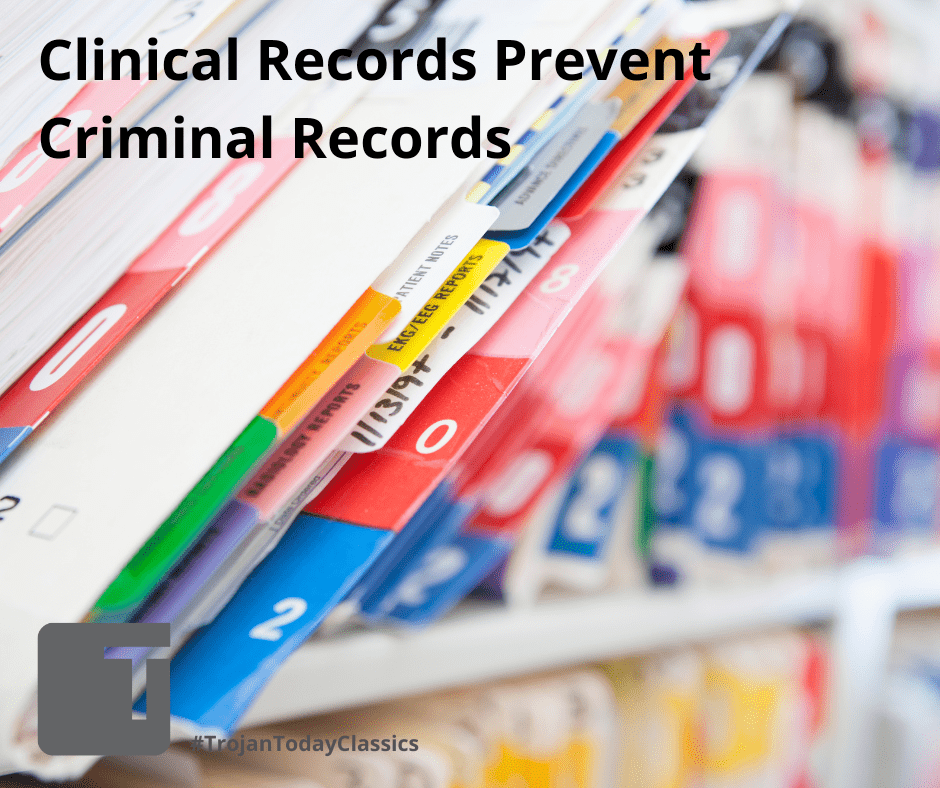This was first published in Trojan Today in 2012. Much has changed in record keeping in 10 years. Many practice management systems have made record keeping easier than ever. If you have questions about how to best use you PMS, contact your program’s support department.
As a dentist, I understand recordkeeping may be the very last item on the provider’s priority list. Been there, done that, and lost the t-shirt…literally. You see, I lost not only my t-shirt, but almost everything I owned, except the love and concern of my family and friends, but that’s another story for another day. I was found guilty of healthcare fraud, racketeering, and structuring just as my son was graduating from dental school. I spent nineteen months in federal prison and two months in a halfway house, forfeited $200,000 as a result of the racketeering and structuring convictions, and paid back the $17,899.57 I received over the course of 6.5 years from the Medicaid program to which I was not entitled.
It is a wise man who learns from his mistake, but a wiser man still who learns from another’s. I learned the hard way that if it’s not in the dental record:
- It was not seen
- It was not said
- It was not heard
- It didn’t need to be done
- It wasn’t done
- It doesn’t exist…from the legal perspective
The dental record can literally make the difference in a jury’s verdict, the dismissal of a malpractice claim, a review by the dental board that finds no grounds for action, or a “clean” insurance audit. In my case, my clinical records did not always contain the necessary information to justify the need for treatment. In fact, I just finished an audit with another doctor and the issues were the same. “The documentation does not support the treatment provided.” This doctor faces significant financial loss. The entity is asking for repayment for the “unjustified” services and the demand is substantial. OUCH!
If it’s not in the dental record, the doctor didn’t see it, didn’t say it, didn’t do it; it didn’t need to be done; and it doesn’t exist from a legal perspective. The doctor must be careful to document in such a way there’s no question left unanswered, no service provided left to the imagination. The dental record should read like a story that has a beginning, middle, and end where everything is recorded. I know, I know. There are only so many hours in a day, but ask me or learn from this doctor who will most probably write a six-figure check. The time taken to document completely would have been very well spent and could very well have prevented these actions. When you are tempted to ignore or put off your recordkeeping, billing, and coding systems, weigh the consequences and choose wisely. Defending yourself and your practice is literally priceless.
What should the record contain?
Comprehensive Medical and Dental History
- Review the history thoroughly at the first visit and update at all subsequent visits
- Revisit with a more comprehensive review as needed (the more compromised the patient’s health, the more often the medical history should be reviewed. Err on the side of caution.)
- Do a Rx review and run a drug interaction screen. Consider using epocrates or lexacon. www.epocrates.com or www.lexi.com
- Review histories before each visit thereafter even if seen two times on the same day
- The histories must be reviewed, documented, and any modifications of treatment necessary as a result of the Medical condition of the patient should be noted and followed
Documented Detailed Clinical Examination
- Remember, an oral cancer screen is mandatory when reporting most examinations for reimbursement. Make note the screening was conducted and the result
Hard and soft tissue exam:
- Soft tissues: lips, gingiva, buccal mucosa, tongue palate
- Periodontal evaluation/charting for every patient (establish your office’s protocol)
- Hard tissues: Bone and teeth
- The record should be complete and specify what information was evaluated to determine the treatment recommended/provided
Radiographs/Photograph
- Record Normal Findings and Abnormal findings including:
- Head and neck
- Soft Tissues/Photos
- Hard Tissues/Radiographs/Photos
TMJ evaluation
Caries Risk Assessment: CAMBRA Chief Complaint
- Why patient is in your office
- Expectations from the patient
- If no problem is stated, record the reason for the visit, i.e. “I need a checkup”
- Be aware the chief complaint may change so note each visit
List a definitive diagnosis
- Treatment Plans should address all abnormalities
- Complete documentation includes the diagnostic tools used to arrive at that definitive diagnosis
- Diagnosis should list the location and extent of the pathology
Informed consent
- Treatment needed
- Reason for treatment recommendations
- Material treatment risks
- Benefits
- Clinically accepted alternatives
- Cost relative to treatment recommendations
Treatment Rendered
- Anesthesia: amounts, types, and locations
- Numbness
- Procedure
- Materials used
- Any negative outcomes
- Does stuff happen?
- Inform
- Deal with additional treatment/referrals
- Refusal of any kind or request to modify treatment
Reason for next appointment
- Treatment should be sequenced to address condition of greatest concern
- Address chief complaint
- Address reason for the sequence
- Get agreement from patient for next appointment
Note any referrals
- Where was patient referred?
- Reason for referral
- Lack of compliance
All prescriptions written
- List prescriptions separately and include number and strengths
- Indicate what prescription is to treat
- Inform patient of any possible side effects
- Inform patient what to do if untoward effects from medications are experienced
- (Check with your state regarding the Rx database)
All phone conversations
- Conversations with business staff
- Conversations with clinical staff
- Conversation with Doctor
- Conversation with referring Doctor regarding the patient
Cancelled/Missed Appointments
- Compliance can be very important to outcomes
Remember!
Notations should be made at the time of the visit, phone call, or conversation.
Note when and why any necessary correction or additions to the record is made.
Subjective comments about the patient are not to be recorded in the treatment record!
Be very careful with your choice of words.
I hear your objections. Charting…ugh!…the most tedious, time-consuming, nonproductive waste of time. That’s what I used to think. My opinion of charting, after having spent several months in Federal Prison and reviewing other records of doctors who are under scrutiny from a third party, has been forever changed.
I’ve learned the chart is the single most important document in the event of an insurance audit, malpractice claim, legal action, board review, or challenge of any kind. What is contained in the treatment record can exonerate you or condemn you, depending on what is there (or what is missing). The clinical record can speak volumes.
Although just a document, it can “testify” of your competence, your attention to detail, or your complete disregard for the treatment of the patient. We make a critical choice every day to take the time to construct a complete, concise, and comprehensive record, or to “let it slide.” Believe me, it’s worth the time and effort to make the appropriate entries, patient by patient, procedure by procedure, day by day!
Please, learn something from my experience. Take a long hard look at your present recordkeeping systems and begin to plug any holes that are found. The time and effort taken to make the necessary improvements serve you and the patient well!

